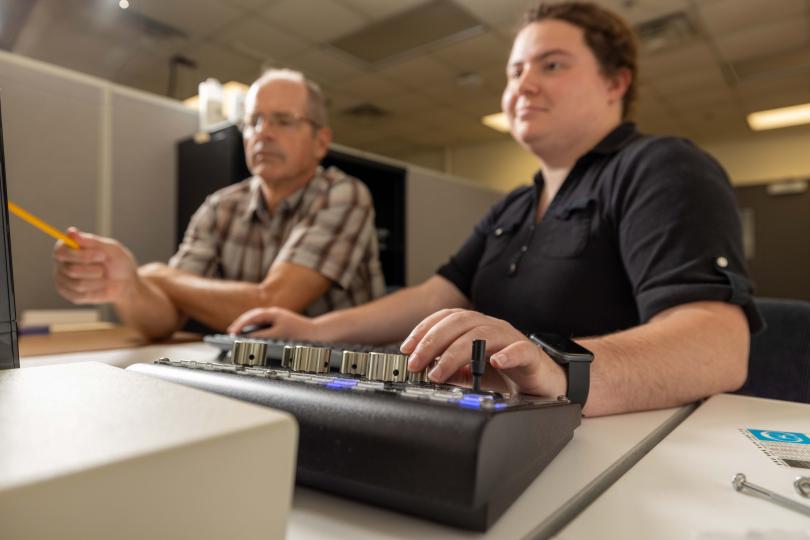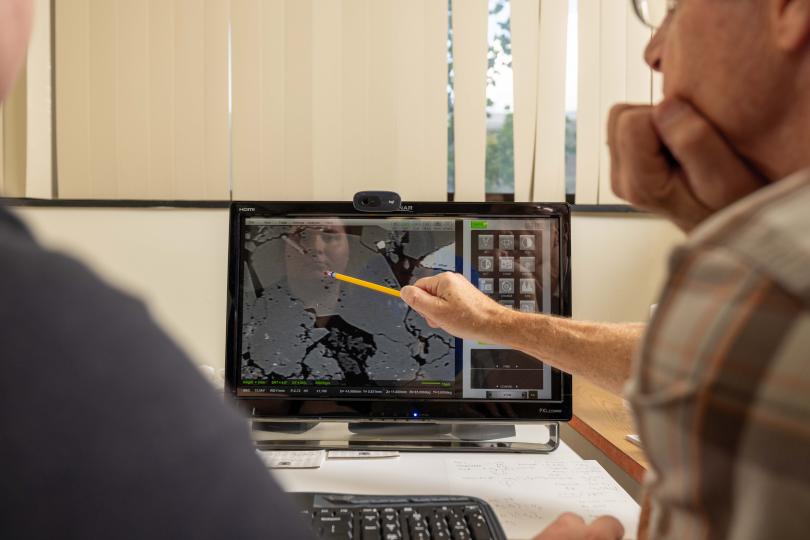By Jennifer T. Allen

What do battery-powered devices (phones, computers and electronic vehicles), air travel, wind-generated power and power transmission have in common?
They all rely on critical minerals derived from the Earth.
In fact, all battery-powered devices rely on these minerals and the reality is that they’re not readily available in the United States. According to two University of Kentucky College of Arts and Sciences professors, the United States relies heavily on foreign sources for these critical minerals, especially those containing the rare-earth elements (REEs).
Dave Moecher and Ryan Thigpen, professors in the Department of Earth and Environmental Sciences, along with colleagues at the Kentucky Geological Survey (KGS) are hoping to help develop more domestic sources for rare-earth elements. They have recently received a $450,000 grant from the U.S. National Science Foundation (NSF) to help alleviate the supply of critical minerals needed for the energy transition and national security.
“Critical minerals contain the elements needed for rechargeable batteries such as lithium and for motors in electrical vehicles, wind turbines and military hardware,” Moecher said. “These elements include the REEs. Currently the majority of REEs in the world are sourced from mines in China or Australia with REE ore refined almost exclusively in China.”
With the United States operating only one REE mine in California, the nation’s geologists need to explore for and develop domestic sources of the REEs to minimize U.S. dependence on foreign sources.
“The need is so critical that both recent U.S. administrations issued executive orders calling for expanded development of domestic sources of critical minerals,” Thigpen said. “Our grant will evaluate REE resources in the southeastern U.S.”
 Moecher and Thigpen responded to a call from the NSF to submit proposals integrating critical mineral exploration into existing Earth science research programs. The two, along with Matthew Massey of the KGS, had been conducting research related to the mineral monazite, the most widespread REE-bearing mineral in the Earth’s crust.
Moecher and Thigpen responded to a call from the NSF to submit proposals integrating critical mineral exploration into existing Earth science research programs. The two, along with Matthew Massey of the KGS, had been conducting research related to the mineral monazite, the most widespread REE-bearing mineral in the Earth’s crust.
“It was a no brainer for our group,” Moecher said. “Along with Professor Scott Samson of Syracuse University, we had already been doing research on monazite – the primary mineral containing the REES - for over a decade. We predict that monazite found in streams, rivers and beach sand in the southeastern U.S. are formed by erosion of the Appalachian Mountains. All that wonderful beach sand along the Carolinas, Georgia and Florida coasts originated this way.”
Now that they have secured the grant, they need to start the fieldwork: sampling rocks in the Appalachian Mountains, and river sand and beach sand in South Carolina, where some of the highest concentrations of monazite are predicted to occur.
“We will examine the samples on the scanning electron microscope to determine what other minerals occur with the monazite as other critical minerals are likely to be present as well,” Moecher said. “We will then use geochemical methods, including zapping monazite grains with a tiny laser beam, to analyze for the abundance of REEs and determine the age of monazite grains. This helps us determine where in the Appalachian Mountains the monazite was derived.”
With the United States currently unable to provide the amount of critical minerals it requires for commercial, industrial and strategic needs, the most direct benefit of the research is to determine if the monazite deposits in South Carolina are an economical source of the REEs, Moecher said. Private companies can then assess whether these deposits are worth developing.
Beyond the discovery of new critical mineral resources, the broader impact of the research includes the education and training of the next generation of Earth scientists. The Department of Earth and Environmental Sciences will be adding graduate students to help conduct the research as well as incorporating undergraduates from UK and high school students from Dunbar High School in Lexington. An Earth science teacher from Dunbar High School will also develop lesson plans related to critical minerals.
“The lack of domestic resources of these critical minerals puts the U.S. at an economic disadvantage and national security risk,” Moecher said. “Reyling on foreign sources also displaces the environmental impact to less developed countries. Our research will potentially help reduce the disadvantage and security risks and develop potential resources in an environmentally sustainable manner.”
Research reported in this publication was supported by the U.S. National Science Foundation under Award No. 2346610. The opinions, findings, and conclusions or recommendations expressed are those of the author(s) and do not necessarily reflect the views of the U.S. National Science Foundation.
